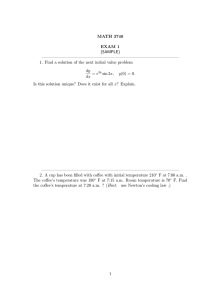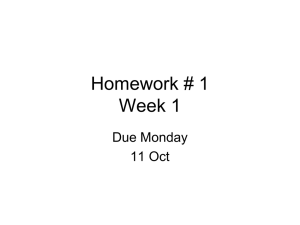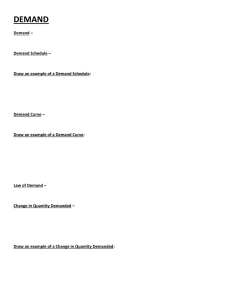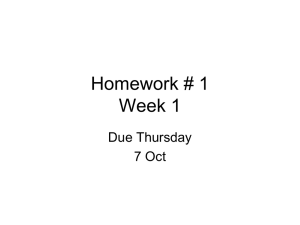Version #1 Econ 101-Spring 2009 Professor Kelly
advertisement
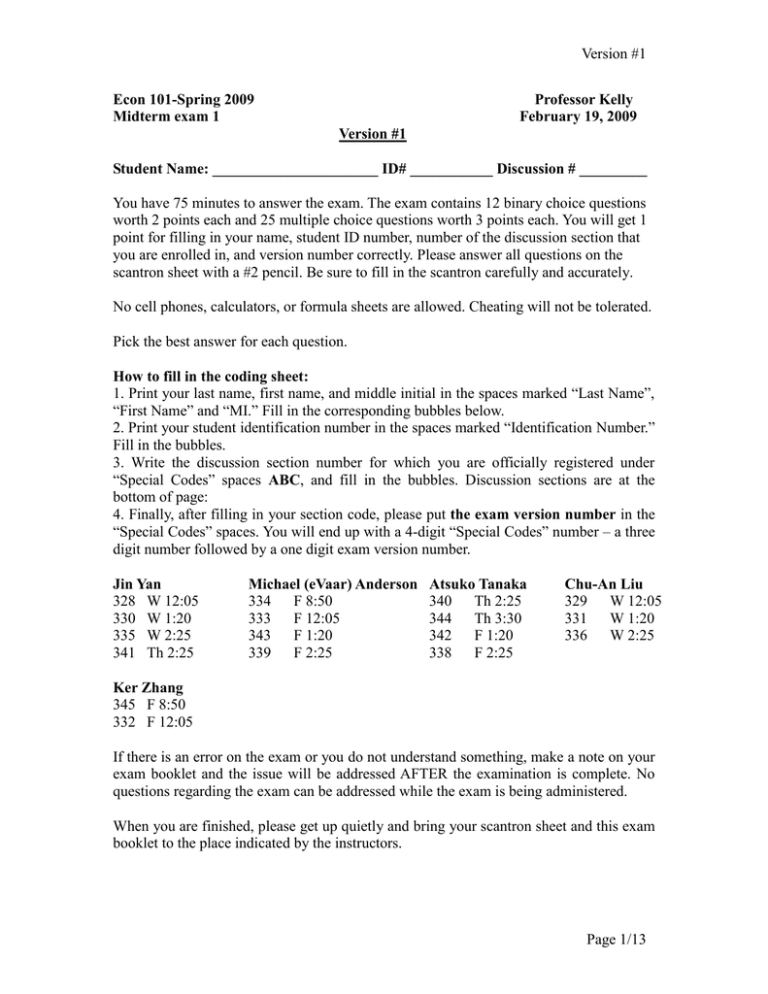
Version #1 Econ 101-Spring 2009 Midterm exam 1 Professor Kelly February 19, 2009 Version #1 Student Name: ______________________ ID# ___________ Discussion # _________ You have 75 minutes to answer the exam. The exam contains 12 binary choice questions worth 2 points each and 25 multiple choice questions worth 3 points each. You will get 1 point for filling in your name, student ID number, number of the discussion section that you are enrolled in, and version number correctly. Please answer all questions on the scantron sheet with a #2 pencil. Be sure to fill in the scantron carefully and accurately. No cell phones, calculators, or formula sheets are allowed. Cheating will not be tolerated. Pick the best answer for each question. How to fill in the coding sheet: 1. Print your last name, first name, and middle initial in the spaces marked “Last Name”, “First Name” and “MI.” Fill in the corresponding bubbles below. 2. Print your student identification number in the spaces marked “Identification Number.” Fill in the bubbles. 3. Write the discussion section number for which you are officially registered under “Special Codes” spaces ABC, and fill in the bubbles. Discussion sections are at the bottom of page: 4. Finally, after filling in your section code, please put the exam version number in the “Special Codes” spaces. You will end up with a 4-digit “Special Codes” number – a three digit number followed by a one digit exam version number. Jin Yan 328 W 12:05 330 W 1:20 335 W 2:25 341 Th 2:25 Michael (eVaar) Anderson 334 F 8:50 333 F 12:05 343 F 1:20 339 F 2:25 Atsuko Tanaka 340 Th 2:25 344 Th 3:30 342 F 1:20 338 F 2:25 Chu-An Liu 329 W 12:05 331 W 1:20 336 W 2:25 Ker Zhang 345 F 8:50 332 F 12:05 If there is an error on the exam or you do not understand something, make a note on your exam booklet and the issue will be addressed AFTER the examination is complete. No questions regarding the exam can be addressed while the exam is being administered. When you are finished, please get up quietly and bring your scantron sheet and this exam booklet to the place indicated by the instructors. Page 1/13 Version #1 Page 2/13 Version #1 Binary Choice Section (each question is worth 2 points) 1. Suppose the domestic market of TVs has a typical downward sloping demand curve and an upward sloping supply curve. Furthermore, suppose the world price is below the closed domestic equilibrium price. The government wants to reduce the quantity of TVs imported to X amount. The government’s economic advisor says, “Only a quota can achieve this goal and the use of a tariff will not be able to reduce the level of imports to X amount.” Is the advisor correct or incorrect? a. Correct b. Incorrect 2. Atsuko likes two types of spread on her toasted bread. She likes to use either Nutella or Vegemite and she does not like to mix the two. What is the relationship between the two products? a. Substitutes b. Complements 3. Suppose that both the demand for the good and the supply of the good increase. We know with certainty that: a. The quantity demanded for the good will increase. b. The price of the good will increase. 4. In the line described by the equation y=(2/7)x+(1/3), x and y are negatively related. a. True b. False 5. Consider the market for paper textbooks. Suppose teachers begin to rely less on textbooks and more often make slides of lecture notes available on the internet. At the same time, the cost of paper increases. Which of the following regarding the equilibrium price and quantity of paper textbooks is true? a. Equilibrium price decreases and equilibrium quantity is ambiguous. b. Equilibrium price is ambiguous and equilibrium quantity decreases. 6. Irrespective of whether a country is an importer or an exporter of a product, the country’s total surplus under an open economy is always at least as big as it is under a closed economy. a. True b. False Page 3/13 Version #1 7. Fill in the blank: When the production possibility frontier between two goods is bowed out from the origin, the opportunity cost of producing a good _________ as more of the good is produced. a. Decreases b. Increases 8. If you are studying Microeconomics, then you are interested in: a. How firms set the price of goods in particular markets. b. The growth in GDP from 2002 to 2003. 9. Consider two countries, Bigski and Littleski. Bigski is very large, rich in natural resources and has a highly trained workforce. Littleski is very small, has few natural resources and an unskilled workforce. Is it possible that Bigski can benefit from trade with Littleski? a. Yes b. No 10. You are at the airport waiting for your flight which will arrive in Denver at 4pm (after one stop). The ticket agent announces that they are looking for a volunteer to give up their seat on your flight. The person who volunteers will be given a seat on the next plane (nonstop to Denver arriving at 4pm), and $100 in compensation. Suppose you decide not to volunteer. How does your decision affect the economic cost of your flight? a. Your flight to Denver just got $100 more expensive. b. Your opportunity cost remains unchanged. 11. “The Federal Reserve ought to utilize all its resources to reduce inflation.”. This statement is: a. Positive b. Normative 12. The demand for a good increases when the price of a substitute ___ or when the price of a complement ___. a. Increases, decreases b. Decreases, increases Page 4/13 Version #1 Multiple Choice Section (each question is worth 3 points) Use the following information to answer the next 3 questions: We’ll consider 2 cities (Mikeville and Jinsberg) which each produce 2 goods: pencils and erasers. Both cities have linear production possibility frontiers. 13. The equation for Jinsberg’s PPF is P=8000–4E (where P=pencils, E=erasers). What is the opportunity cost of producing a pencil in Jinsberg? a. 2 erasers b. ¼ of an eraser c. 4 erasers d. ½ of an eraser 14. At maximum efficiency, Mikeville is capable of producing 500 erasers and 7,500 pencils, or 0 pencils and 1000 erasers. What is the equation for Mikeville’s PPF? a. P = 10,000 – 10E b. P = 10,000 – 15E c. P = 15,000 – 10E d. P = 15,000 – 15E 15. Using the information from the above two questions, fill in the blanks: _______ has the absolute advantage in producing pencils. _______ has the comparative advantage in producing pencils. a. Jinsberg, Jinsberg b. Jinsberg, Mikeville c. Mikeville, Jinsberg d. Mikeville, Mikeville Page 5/13 Version #1 16. Consider the market for oil. Suppose the demand curve is a vertical line and the supply curve is a straight non-vertical line with a positive slope. If the government imposes an excise tax on the producers of this market, which of the following statement is TRUE? a. The economic burden of the tax falls on producers and consumers equally. b. The sellers bear some economic burden of the tax, but consumers bear most of the economic burden of the tax. c. The sellers must bear most of the economic burden of the tax. d. The consumers bear the entire economic burden of the tax. Use the following diagram to answer the next question. 17. Looking at the above graph which statement must be true? a. The opportunity cost of producing a hammer is lower in Country A than in Country B. b. The opportunity cost of producing a wrench is lower in Country A than Country B. c. Country A has the absolute advantage in producing wrenches. d. Country A has the absolute advantage in producing hammers. Page 6/13 Version #1 Use the following information to answer the next 4 questions: The domestic demand and domestic supply for coffee (in pounds) for a small economy is given by the following equations: Domestic demand for coffee (in pounds): P = -QD + 13. Domestic supply of coffee (in pounds): P = 2Qs + 1. The world price of 1 pound of coffee is $4. 18. Suppose the government opens up this economy to trade. What is the change in total surplus? Total surplus a. Increases by 50/4 b. Increases by 75/4 c. Increases by 85/4 d. Decreases by 85/4 19. Assume that this economy is open to world trade. Suppose that the government implements an import quota of 4 pounds of coffee. What is the new equilibrium price in this economy given this import quota? a. $(19/3) or $6.33 b. $4 c. $(35/3) or $11.67 d. $3 20. Assume that this economy is open to world trade. Suppose that the government implements a tariff of $1 on each pound of imported coffee. (There is no quota.) What is the deadweight loss compared to an open economy without government intervention? a. $(3/2) or $1.50 b. $1 c. $(3/4) or $.75 d. $(1/2) 21. Assume that this economy is open to world trade. If the world price of coffee per pound was $12 instead of $4, what would happen in the coffee market? a. Domestic consumers would stop purchasing coffee. b. Domestic producers would produce more coffee than is demanded in the market, and there would be an excess supply of coffee. c. The country would import coffee. d. The country would export coffee. Page 7/13 Version #1 Use the following diagram to answer the next 3 questions: P 15 a b e f c 10 d g 5 100 130 160 Q 22. If the government imposes an excise tax of $10 per unit in the above market, what is the price paid by consumers (P) and the price received by sellers (Pnet)? a. P = $10, Pnet = $10 b. P = $15, Pnet = $5 c. P = $15, Pnet = $10 d. P = $10, Pnet = $0 23. Total tax revenue for the government after the $10 excise tax is imposed is equal to a. area (A+B+C+D+E+F+G) b. area (B+C+D+F+G) c. area (A+E) d. area (B+F) 24. What is the change in consumer surplus after the $10 excise tax is imposed? Consumer surplus a. Decreases by area (A+B) b. Decreases by area (A) c. Decreases by area (B) d. Decreases by area (B+F) Page 8/13 Version #1 25. Which of the following is not a normative statement? a. Everybody ought to be paid the same hourly wage, because everyone is created equal. b. Macroeconomics is less helpful to consumers than microeconomics. c. It is more important to fix inflation than to reduce unemployment. d. The equilibrium price is the price level such that the quantity demanded is equal to the quantity supplied. 26. All of the following explain how macroeconomics differs from microeconomics except: a. Macro is concerned more with aggregate figures. b. Macro provides a broader view of economic activity. c. Micro provides figures for the CPI ( the Consumer Price Index which is one measure of the general price level in an economy) and GDP. d. Micro is more concerned with optimal decisions by consumers. Use the following information to answer the next 2 questions: The following table summarizes Sarah and Matt’s production possibilities if they specialize only in that subject (for example, if Sarah only produces Math solutions she can produce 12 math solutions per hour). Math Chemistry Solutions/hr Solutions/hr Sarah 12 8 Matt 10 8 Assume that both Sarah and Matt have linear PPFs between solutions to chemistry questions and solutions to math questions. 27. What is the smallest number of chemistry solutions Sarah will accept in trade from Matt for a math solution? a. 2/3 of a chemistry solution b. 3/2 chemistry solutions c. 2 chemistry solutions d. 3 chemistry solutions 28. What is the maximum number of chemistry solutions Matt will trade for a math solution from Sarah? a. 4/5 of a chemistry solution b. 5/4 chemistry solutions c. 4 chemistry solutions d. 5 chemistry solutions Page 9/13 Version #1 Use the following information to answer the next 3 questions: Let the market demand curve of wheat be P=7-Q. Let the market supply curve of wheat be P=1+2Q. 29. Now suppose the government sets a floor on the price of wheat; i.e. it declares that the price of wheat cannot be lower than $6. Find the quantities demanded and supplied at the new price of $6. a. Quantity demanded = 2, Quantity supplied = 4 b. Quantity demanded = 1, Quantity supplied = 3 c. Quantity demanded = 3, Quantity supplied = 1 d. Quantity demanded = 1, Quantity supplied = 2.5 30. As a result of the imposition of the price floor described in the previous question, the government decides to purchase the excess supply. Calculate the total cost of the program to the government. Assume that there are no storage costs associated with the government purchasing the excess supply. a. $6 b. $8 c. $9 d. $10 31. Suppose the government wants suppliers of wheat to earn $6 for each pound sold. However the government decides to offer a subsidy for each pound sold rather than purchasing the excess supply. How much subsidy does the government have to offer for each pound of wheat? a. $0.5 b. $1 c. $1.5 d. $2 Page 10/13 Version #1 Use the following information to answer the next 2 questions: Let the horizontal axis be the x variable and the vertical axis be the y variable. The equation for line A is y=(1/3)x-7 and the equation for line B is y=(2/3)x-2. 32. What is the x-intercept of line B? a. 3 b. -2 c. -7 d. 21 33. What is the intersection of line A and line B? a. (x = -12, y = -15) b. (x = 12, y = 15) c. (x = -15, y = -12) d. (x = 15, y = 2) 34. The demand for a week’s worth of newspaper delivery in Madison is given by the equation Qd=220-20P. There are two daily papers, the supply curve for the first daily paper is given by the equation Qs=20P-10, while the supply curve for the second daily paper is given by the equation Qs=20P-10 (both daily papers have the same individual supply curve) . What is the equilibrium price for a week’s worth of delivered newspapers? a. $4.00 b. $5.75 c. $7.5 d. $7.67 Page 11/13 Version #1 Use the following diagram to answer the next 2 questions: 35. The equation of the demand curve is a. Qd = 10 - 2P b. Qd = 20 - 2P c. Qd = 10 - (1/2)P d. Qd = 20 + (1/2)P 36. What will the slope of the supply curve have to be for the market equilibrium to be at P = 5, Q = 10? a. 5/8 b. 8/5 c. 3/10 d. 10/3 37. Holding everything else constant, which of the following will shift the supply curve for good X to the left? a. A shortage in X b. A fall in the wages of workers who produce good X c. An increase in the cost of equipment used in the production of good X d. Innovations that increase the efficiency of the production technology for good X Page 12/13 Version #1 Solution: 1. B 2. A 3. A 4. B 5. B 6. A 7. B 8. A 9. A 10. A 11. B 12. A 13. B 14. D 15. D 16. D 17. A 18. B 19. A 20. C 21. D 22. B 23. C 24. A 25. D 26. C 27. A 28. A 29. D 30. C 31. C 32. A 33. C 34. A 35. B 36. C 37. C Page 13/13


